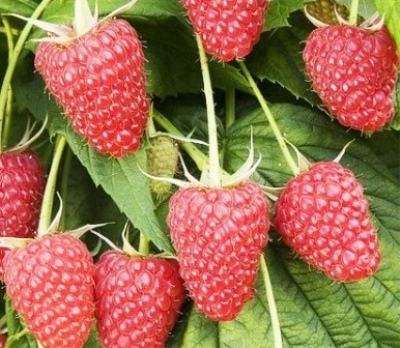
- Berry color: bright pink, dark crimson
- Taste: sweet and sour
- Ripening period: late
- Berry weight, g: 4-5 g
- Yield: 2-3 kg per bush
- Frost resistance: winter hardy
- Appointment: universal
- Fruiting period: 3rd decade of July
- Raspberry mite resistance: stable
- Resistance to adverse weather factors: when the tops of the shoots freeze in winter, the yield is compensated by the formation of powerful fruit branches in the lower part of the stems
For a long time, the achievements of domestic breeding science had no competition on the country's garden plantations. With the advent of new products from foreign breeding, the situation has changed. And yet, many gardeners prefer Russian, proven raspberry varieties that do not need to undergo acclimatization. One of these varieties is Tourmaline.
Breeding history of the variety
The Tourmaline variety is obtained by crossing frost-resistant raspberry varieties from Scotland. Was taken out at the Sverdlovsk Experimental Gardening Station. It is one of the oldest scientific institutions in the industry, founded in 1935. The leading employees of the enterprise became the breeders of Tourmaline: L. I. Chistyakova and I. I. Bogdanova.
Description of the variety
Tourmaline is a raspberry of a late ripening period, good yield, universal in purpose, with large sweet and sour fruits. Forms bushes up to 2 m high with erect shoots without thorns. It is characterized by resistance to the main diseases of the species. Perfectly transported and stored without changing the color and shape of the berries.
Ripening terms
The variety is late ripening. The ripening period occurs in the third decade of July before the first frost. Long fruiting occurs due to the gradual flowering of the bush: flowers appear first at the top of the shoot, then in the middle and then at the very bottom. Because of this feature, such varieties are called semi-renovated.
Yield
The yield is not bad: Tourmaline gives from 2 to 3 kg of berries per bush per season. Subject to the rules of agricultural technology, you can collect up to 56 kg of fruits from a hundred square meters. The harvesting process is simplified by the lack of thorns on the branches.
Yield is influenced by the planting density of the bushes and the quality of the soil.
Berries and their taste
Raspberry fruits Tourmaline are large, elastic, elongated conical shape, bright pink and dark crimson color by the time of full ripening. The color, similar to the shade of the semi-precious stone tourmaline, is the reason for the name of the variety. Berries usually weigh 4-5 g, but can reach 7 g. They have a pleasant sweet and sour taste, perfect for juices, compotes, desserts and freezing. They can hang on the branches for a long time, they are easily removed after ripening, the drupes do not crumble. They tolerate transportation very well, they are stored without changing the presentation.

Growing features
Tourmaline is a variety that is quite demanding on the fertility and level of acidity of the soil. It needs to be stimulated with nitrogen fertilization in the spring and potash during ripening. Grows best in sunny areas with good drainage. High branches need support. Pollinated independently.Berries and bushes do not burn in the sun, they tolerate dry summers well if they receive timely watering. During the season, watering is carried out about 10 times, 10 liters under a bush.
Tourmaline requires mandatory pruning: moderately thickened raspberry bushes should be thinned out in the fall, removing the sprouted shoots.
Site selection and soil preparation
Tourmaline is best planted on a flat, sunny, weed-free area. It is imperative to maintain a distance of 0.5-0.6 m between bushes and 2-2.5 m between rows. The soil should contain humus, be loose, not too acidic (from 5.7 to 6.6 pH). Before planting, the soil must be fertilized with potassium salt or wood ash. So that the moisture at the roots does not evaporate quickly, you can put a layer of straw, hay or peat.





Frost resistance and preparation for winter
The winter hardiness of the variety is good, because the breeders provided for its cultivation in the conditions of the Middle Urals. The plant is only bent down for the winter so that the bushes are covered with snow. In winters with little snow, raspberries are covered with agrotechnical or spruce branches.
If the plant is not bent, then the tops of the bush may freeze, however Tourmaline is able to recover quickly: powerful fruit branches grow from the lower part of the shoots.

Diseases and pests
Tourmaline is not affected by gray mold and raspberry mites and is resistant to fungal infections. The only threat is the purple spot, which appears in August. Fungicides can protect the plant from it, as well as timely pruning.
This raspberry grows well even in urban areas in the private sector: it firmly tolerates the gas pollution of the air of a large city.

Unfortunately, raspberries, like other plants, do not bypass various diseases and pests. Only armed with the knowledge and the necessary means for this, you can cope with such troubles. To help the plant, it is very important to be able to recognize the disease in time and begin timely treatment.
Reproduction
Tourmaline is bred both by root cuttings and by green shoots or by dividing the bush.
When propagating by root cuttings in the fall, the roots (15 cm) are separated from healthy bushes, placed in containers with soil in a cool place. The roots are watered once a month. The container is transferred to the greenhouse in the spring, where the seedlings grow stronger until the fall, after which they are already planted in the raspberry tree.
When dividing a bush, you can get about 6 new plants. Such reproduction is carried out in the spring. Green shoots with a height of 15-20 cm are also separated in the spring and planted in prepared holes.








































































